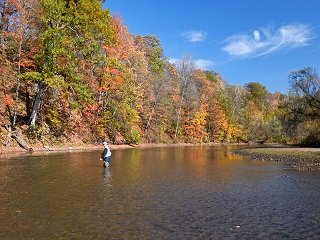 It can be difficult to wrap one’s head around the concept of planning your fishing outings based on the reproduction of local insects, but when it comes to fly fishing, that’s the breaks. Insects dictate what flies to use, what time of day to fish, and even when to fish during the season. It’s funny to think that these tiny creatures have such power over fly fishing. As the seasons change, so does insect activity, and this fall, fly anglers will have to come to terms with a potential decrease in activity when they hit the water. Not to worry, however, as today I’ll provide you with a few tips on how you can still wrangle trout to the banks this fall.
It can be difficult to wrap one’s head around the concept of planning your fishing outings based on the reproduction of local insects, but when it comes to fly fishing, that’s the breaks. Insects dictate what flies to use, what time of day to fish, and even when to fish during the season. It’s funny to think that these tiny creatures have such power over fly fishing. As the seasons change, so does insect activity, and this fall, fly anglers will have to come to terms with a potential decrease in activity when they hit the water. Not to worry, however, as today I’ll provide you with a few tips on how you can still wrangle trout to the banks this fall.
In the spring, trout fishing sees a boom of activity due to the numerous insect hatches that occur during the season. Fall brings the exact opposite for most regions, in the form of ant species emerging from their colonies after sprouting wings and dying along the water’s surface once they reproduce. Trout take advantage of this and feed on the ants. The activity won’t be as plentiful as the spring, and trout won’t feed as much, but you can still hook into some beauties.
One plus to fall fly fishing is the decrease in anglers present on the river. Yes, you’ll have more space to move around and find peace, but, as I said before, the fishing activity isn’t as bustling as it is in the spring, so that solitude comes with a cost. If you’re lucky, and the temperatures stay reasonably mild, though, the best action occurs between sunrise and mid-morning, and then picks up again later on in the evening. Once temperatures consistently stay around 50 degrees, midday to evening is the time to be on the water.
When it comes to what flies to use, there are a few options that do well this time of year. Surprisingly enough to some, there are several different mayfly species that are abundant and choosing a fly that matches will work wonders. Many also forget that fall is prime time for grasshoppers and beetles to be active. Whatever fly you end up using, however, be sure to keep in mind that many leaves, seeds, and other debris find their way to the river and distinguishing between such objects and food can be difficult for trout. To make your fly enticing and catch a fish’s eye, try to give it a little twitch during the drift.
Rivers tend to be slower and clearer in the fall, which means you might have to alter your tackle a bit. I suggest switching to a longer leader, in order to keep from spooking the fish. Once November comes around, trout tend to hold in deep pools, so you’ll also want to switch to wet flies, such as streamers, and perhaps tie on a sink-tip line.
While it’s important to change presentation and flies to “match the hatch,” don’t forget to keep some of your tried and true favorites handy. Be observant when it comes to insect activity on your nearest river and be prepared to adjust accordingly on the fly (no pun intended). Fall may not be the whirlwind of activity that spring is, but that doesn’t mean you can’t still catch trout.








